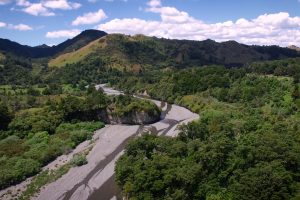New Zealand’s Royal Family
For many years I lived at Portobello, on the Otago Peninsula, near Dunedin. At the weekend I’d often head out on my bike to Taiaroa Head, at the tip of the peninsula. What drew me there were the albatrosses – the only mainland colony of albatrosses anywhere in the world.
As I approached I’d start scanning the birds circling the headland. There were always gulls – thousands of red-billed gulls, flapping and jostling, and amongst them the much larger southern black-backed gulls, sedately moving their wings up and down. On many occasions I heard eager tourists convincing themselves that these large birds must be the much-talked about albatross. But then, if we were lucky and there was enough wind a truly enormous bird would glide into view, a seabird on steroids, with its extraordinary long wings locked into effortless flight mode. Without flapping, skimming just 20 or so metres above the ground, it would pass over the visitor’s centre and disappear around the headland. The chattering tourists would fall quiet, as with tilted heads and often open mouths they watched the elegant royal pass.
These birds are almost all wing – the northern royal albatrosses at Taiaroa Head may stretch 3.25 metres from wingtip to wingtip; their cousins the southern royal albatrosses have the longest wingspan of any bird in the world, up to 3.6 metres across. They are the ultimate long-distance flying machines. Author Carl Safina writes ‘An albatross is bone, feathers, muscle, and the wind. An albatross is its own taut longbow, the breeze its bowstring, propelling its projectile body.’
New Zealand is albatross capital of the world, with 14 different kinds breeding on our offshore islands, as well at Taiaroa Head – and they’re here because of the wind. The Roaring Forties and the Furious Fifties are the albatross latitudes. These great ocean travellers ride those relentless winds round and round the globe. Researcher Chris Robertson attached satellite transmitters to Taiaroa Head albatrosses, and found they could fly up to 1800 kilometres in a single day, often soaring at speeds of 80-110 kilometres per hour for up to 14 hours a day. They spend more than 80% of their lives at sea, coming to land only to breed. During its long lifetime – 60-years and more – an albatross will fly many tens of millions of kilometres.
When an albatross chick leaves the Taiaroa Head colony for the first time it is nearly a year old, and it won’t touch land again for the next six or seven years. When an albatross sleeps it does so on the water. When a young albatross finally returns to its place of birth to find a mate it will take its time. A group of albatrosses holding court and displaying to each other is a magical sight. They have elaborate choreographed rituals of sky calling and dancing, during which they throw their wings back, and point their bills to the sky. They shake their heads back and forth, clap their bills and utter ecstatic high-pitched calls. Over several years pairs begin to form, and as they cement their new relationship they begin to touch each other, preening one another gently. Only when they are sure of one another do they begin to breed. It takes a year to raise a single chick, and both parents need to commit 100% of their energy to the task. When that year is over the pair take a well-deserved year off. It’s back to sea, to the endless circumnavigation of the southern ocean.
As New Zealanders we’ve always prided ourselves on being great travellers, so it’s fitting we should vote to have a bird which is the ultimate traveller as New Zealand’s Bird of the Year for 2013. Can you help us make this the first time a seabird wins Bird of the Year? After all, New Zealand is Global Seabird Central! Come for a ride with us over the next few weeks as we introduce you to different kinds of albatrosses, share stories and photos with you, and meet amazing albatross researchers. We’d love to hear your stories, too – where have you encountered albatrosses? Have you, too, seen them at Taiaroa Head, or perhaps from a fishing boat or a Cook Strait ferry? Have you read the Rime of the Ancient Mariner? (We haven’t – but we’re planning to).
You can follow us on Twitter – @AlisonBallance
or on our Facebook page – Vote Albatross
And if you live in Auckland keep an eye out for albatrosses appearing around town – my co-campaigner Mandy Herrick is going to be using street art to spread the word to Vote Albatross. Take a selfie with one of the Auckland albatrosses and we’ll post it on Facebook.
And of course: don’t forget to vote! – and albatross is the first bird on the list so it’s easy to find. Spread the word – Vote Albatross.



